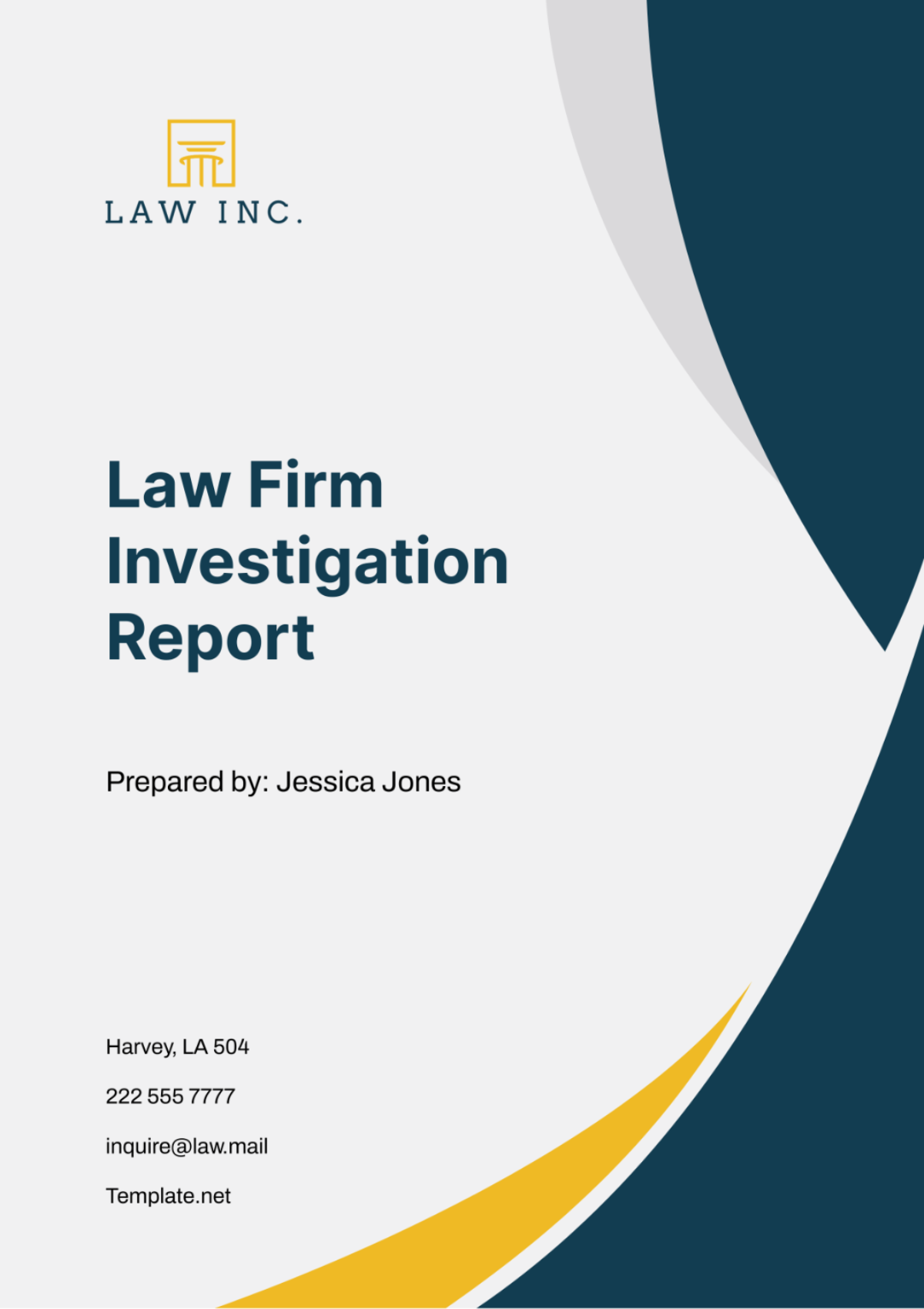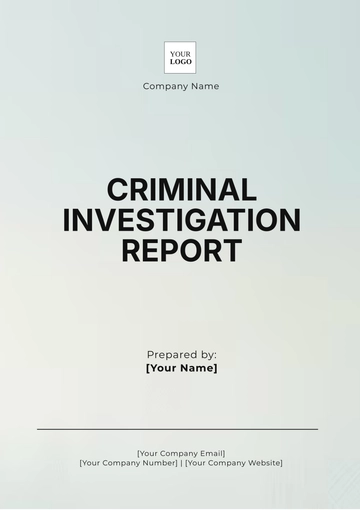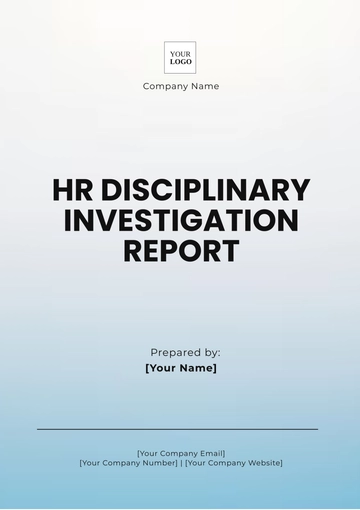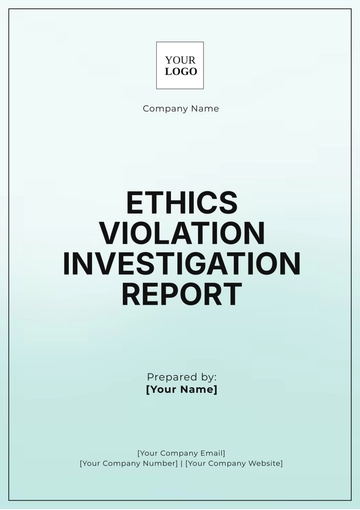Free Law Firm Investigation Report

I. Introduction
A. Purpose of the Investigation
The purpose of this investigation is to delve into the intricate legal matters surrounding the employment dispute between [Client Name] and [Opposing Party]. At the core of this case lie allegations of wrongful termination, breach of contract, and discriminatory practices. The multifaceted nature of the claims necessitates a thorough investigation to unearth facts, assess legal implications, and provide strategic guidance to our client. By undertaking this investigation, our aim is to equip [Client Name] with the insights needed to navigate this complex legal terrain effectively.
B. Scope of the Investigation
The investigation will cast a wide net, encompassing various critical areas central to the dispute:
Employment Contracts: Our team will meticulously review the employment contracts and agreements signed between [Client Name] and [Opposing Party]. This scrutiny will help identify any clauses, obligations, or rights pertinent to the case.
Termination Circumstances: Delving into the circumstances leading to the termination of [Client Name]'s employment is pivotal. By examining the sequence of events and assessing compliance with relevant employment laws and company policies, we aim to uncover the truth behind the termination decision.
Discrimination Allegations: Allegations of discrimination based on age, gender, and disability require careful examination. Our investigation will scrutinize any instances or patterns of discriminatory behavior, ensuring a thorough assessment in line with anti-discrimination laws.
Breach of Contract Claims: Claims of breach of contract pertaining to compensation, benefits, or other contractual obligations demand meticulous scrutiny. Through detailed analysis and comparison against legal standards, we aim to determine the validity of such claims.
Witness Testimonies: Conducting interviews with relevant witnesses is crucial to corroborate facts, gather firsthand accounts, and unearth additional evidence. Witness testimonies will provide valuable insights into the events leading to the dispute and any discriminatory practices or contractual breaches.
Document Review: Our team will undertake a comprehensive review of all relevant documents, including but not limited to employment contracts, performance evaluations, disciplinary records, correspondence, and any documentation related to discrimination complaints or investigations.
II. Methodology
A. Data Collection
The investigation will involve a meticulous process of data collection from diverse sources, ensuring a comprehensive understanding of the case. Key sources of data include:
Financial Records: Reviewing financial documents such as payroll records, compensation agreements, and financial statements to ascertain compliance with contractual obligations and assess any financial implications of the dispute.
Legal Documents: Scrutinizing legal documents including employment contracts, company policies, and any legal correspondence to identify rights, obligations, and potential breaches under applicable laws.
Witness Testimonies: Conducting structured interviews with relevant individuals, including [Client Name], representatives from [Opposing Party], colleagues, supervisors, and HR personnel, to gather testimonies, insights, and additional evidence crucial to the case.
Communication Records: Analyzing communication records such as emails, memos, and other documentation to trace the communication trail, identify relevant discussions or agreements, and uncover any discrepancies or contradictions.
B. Interviews
Interviews will be conducted with a focus on gathering firsthand accounts, clarifying discrepancies, and obtaining additional evidence. Key individuals to be interviewed include:
[Client Name]: To provide detailed insights into their employment history, the circumstances leading to termination, and any experiences of discrimination or contractual breaches.
[Opposing Party]: To understand their perspective on the dispute, the rationale behind the termination decision, and their response to the allegations raised by [Client Name].
Witnesses: To corroborate facts, provide additional context, and offer insights into the events leading to the dispute, discriminatory practices, or contractual breaches.
C. Document Review
All relevant documents will undergo thorough scrutiny to extract valuable insights, identify key evidence, and establish a factual basis for the investigation. Documents to be reviewed include:
Employment Contracts and Agreements: To identify rights, obligations, and terms relevant to the dispute, including provisions related to termination, compensation, benefits, and non-discrimination.
Performance Evaluations and Disciplinary Records: To assess the employee's performance history, any disciplinary actions taken, and their relevance to the termination decision.
Correspondence: To trace the communication trail between [Client Name] and [Opposing Party], including emails, memos, letters, and any documentation relevant to the dispute.
Discrimination Complaints or Investigations: To review any documentation related to past discrimination complaints, investigations, or actions taken by the company, providing insights into the organizational culture and response to discrimination allegations.
III. Findings
A. Financial Analysis
The financial analysis conducted as part of the investigation revealed several key findings:
Salary Discrepancies: Discrepancies were identified between the salary specified in [Client Name]'s employment contract and the actual payments made by [Opposing Party]. This suggests potential breaches of contractual obligations regarding compensation.
Unpaid Benefits: Our review of financial records uncovered instances where [Client Name] was not provided with benefits outlined in the employment agreement, such as healthcare coverage and retirement contributions. This raises concerns regarding compliance with employment laws and contractual obligations.
Severance Package: Analysis of severance package details revealed discrepancies between the terms offered to [Client Name] upon termination and the contractual entitlements. This discrepancy suggests potential violations of contractual agreements and employment laws regarding termination benefits.
B. Legal Review
The legal review conducted by our team unearthed significant findings:
Breach of Contract: It was determined that [Opposing Party] breached several provisions of [Client Name]'s employment contract, including failure to provide the agreed-upon compensation and benefits. These breaches have legal implications and may entitle [Client Name] to remedies under contract law.
Discrimination Allegations: Evidence gathered during the investigation supports [Client Name]'s allegations of discrimination based on age and gender. Instances of differential treatment and disparate impact were identified, indicating potential violations of anti-discrimination laws.
Wrongful Termination: Our legal analysis revealed that [Client Name]'s termination was conducted in violation of employment laws and contractual provisions. The lack of proper justification and procedural irregularities suggest wrongful termination, entitling [Client Name] to legal recourse.
C. Witness Testimonies
Witness testimonies provided crucial insights into the circumstances surrounding the dispute:
Discriminatory Practices: Witnesses corroborated [Client Name]'s claims of discriminatory practices within the workplace, including biased treatment in promotion decisions and hostile work environment.
Termination Process: Witnesses provided accounts of the termination process, highlighting procedural irregularities and lack of justification provided by [Opposing Party]. These testimonies strengthen [Client Name]'s case for wrongful termination.
Contractual Breaches: Witnesses confirmed instances where [Opposing Party] failed to fulfill contractual obligations, such as providing promised benefits and adhering to termination procedures outlined in employment contracts.
IV. Analysis
A. Financial Implications
The findings from the financial analysis have significant implications for the case:
Monetary Damages: The identified salary discrepancies, unpaid benefits, and improper severance package offer suggest potential monetary damages owed to [Client Name] by [Opposing Party]. These damages may include back pay, benefits, and compensation for emotional distress.
Contractual Remedies: Breaches of contractual obligations regarding compensation and benefits may entitle [Client Name] to specific performance remedies, requiring [Opposing Party] to fulfill their contractual obligations as outlined in the employment agreement.
B. Legal Implications
The legal findings carry important implications for the legal strategy and potential outcomes of the case:
Legal Claims: The identified breaches of contract, instances of discrimination, and wrongful termination provide grounds for legal claims against [Opposing Party]. Pursuing legal action based on these claims may result in remedies such as reinstatement, compensation, and injunctive relief.
Regulatory Compliance: Addressing discriminatory practices within the workplace requires [Opposing Party] to implement corrective measures to ensure compliance with anti-discrimination laws and promote a diverse and inclusive work environment.
C. Impact on the Case
The findings and analysis significantly impact the trajectory of the case:
Strengthens Client's Position: The evidence gathered strengthens [Client Name]'s position in the dispute, providing legal grounds for pursuing claims against [Opposing Party] and increasing the likelihood of a favorable outcome.
Informs Legal Strategy: The findings inform the development of a strategic legal approach, guiding decisions regarding negotiation, litigation, and settlement discussions. Leveraging the identified legal and factual strengths enhances [Client Name]'s bargaining power and positions them for success in resolving the dispute.
V. Recommendations
A. Legal Strategy
Based on the findings and analysis, the following legal strategy is recommended:
Litigation: Pursue litigation against [Opposing Party] for breaches of contract, wrongful termination, and violations of anti-discrimination laws. File a lawsuit in [Jurisdiction] seeking damages, reinstatement, and injunctive relief.
Negotiation: Engage in negotiation with [Opposing Party] to explore the possibility of reaching a settlement out of court. Utilize the identified strengths of [Client Name]'s case to negotiate favorable terms, including financial compensation, reinstatement, and implementation of corrective measures.
Alternative Dispute Resolution (ADR): Consider alternative dispute resolution methods such as mediation or arbitration to resolve the dispute amicably and cost-effectively. Collaborate with [Opposing Party] to find mutually beneficial solutions while preserving [Client Name]'s rights and interests.
B. Risk Mitigation
To mitigate risks and strengthen [Client Name]'s position, the following actions are advised:
Document Retention: Maintain thorough documentation of all communications, agreements, and incidents related to the dispute to provide a robust evidentiary foundation in legal proceedings.
Employee Training: Implement training programs for employees and managers to raise awareness of anti-discrimination laws, company policies, and procedures, fostering a culture of inclusion and compliance within the organization.
Legal Compliance Review: Conduct regular reviews of employment contracts, policies, and practices to ensure compliance with applicable laws and mitigate the risk of future disputes or legal challenges.
VI. Conclusion
A. Summary of Findings
The investigation has unearthed compelling evidence of breaches of contract, discriminatory practices, and wrongful termination by [Opposing Party]. The findings provide [Client Name] with a solid legal basis for pursuing remedies through litigation, negotiation, or alternative dispute resolution.
B. Next Steps
The next steps in the resolution of the dispute involve implementing the recommended legal strategy, pursuing legal action against [Opposing Party], and seeking remedies to address the injustices faced by [Client Name]. Additionally, proactive measures to mitigate future risks and promote a fair and inclusive workplace environment should be undertaken.
- 100% Customizable, free editor
- Access 1 Million+ Templates, photo’s & graphics
- Download or share as a template
- Click and replace photos, graphics, text, backgrounds
- Resize, crop, AI write & more
- Access advanced editor
Efficiently document findings with Template.net's Law Firm Investigation Report Template. This editable and customizable document ensures thorough recording of investigative details, maintaining accuracy and professionalism. Crafted by legal experts, it aligns with industry standards and best practices. Editable in our Ai Editor Tool for seamless customization and integration into your firm's investigative process.
You may also like
- Sales Report
- Daily Report
- Project Report
- Business Report
- Weekly Report
- Incident Report
- Annual Report
- Report Layout
- Report Design
- Progress Report
- Marketing Report
- Company Report
- Monthly Report
- Audit Report
- Status Report
- School Report
- Reports Hr
- Management Report
- Project Status Report
- Handover Report
- Health And Safety Report
- Restaurant Report
- Construction Report
- Research Report
- Evaluation Report
- Investigation Report
- Employee Report
- Advertising Report
- Weekly Status Report
- Project Management Report
- Finance Report
- Service Report
- Technical Report
- Meeting Report
- Quarterly Report
- Inspection Report
- Medical Report
- Test Report
- Summary Report
- Inventory Report
- Valuation Report
- Operations Report
- Payroll Report
- Training Report
- Job Report
- Case Report
- Performance Report
- Board Report
- Internal Audit Report
- Student Report
- Monthly Management Report
- Small Business Report
- Accident Report
- Call Center Report
- Activity Report
- IT and Software Report
- Internship Report
- Visit Report
- Product Report
- Book Report
- Property Report
- Recruitment Report
- University Report
- Event Report
- SEO Report
- Conference Report
- Narrative Report
- Nursing Home Report
- Preschool Report
- Call Report
- Customer Report
- Employee Incident Report
- Accomplishment Report
- Social Media Report
- Work From Home Report
- Security Report
- Damage Report
- Quality Report
- Internal Report
- Nurse Report
- Real Estate Report
- Hotel Report
- Equipment Report
- Credit Report
- Field Report
- Non Profit Report
- Maintenance Report
- News Report
- Survey Report
- Executive Report
- Law Firm Report
- Advertising Agency Report
- Interior Design Report
- Travel Agency Report
- Stock Report
- Salon Report
- Bug Report
- Workplace Report
- Action Report
- Investor Report
- Cleaning Services Report
- Consulting Report
- Freelancer Report
- Site Visit Report
- Trip Report
- Classroom Observation Report
- Vehicle Report
- Final Report
- Software Report





























